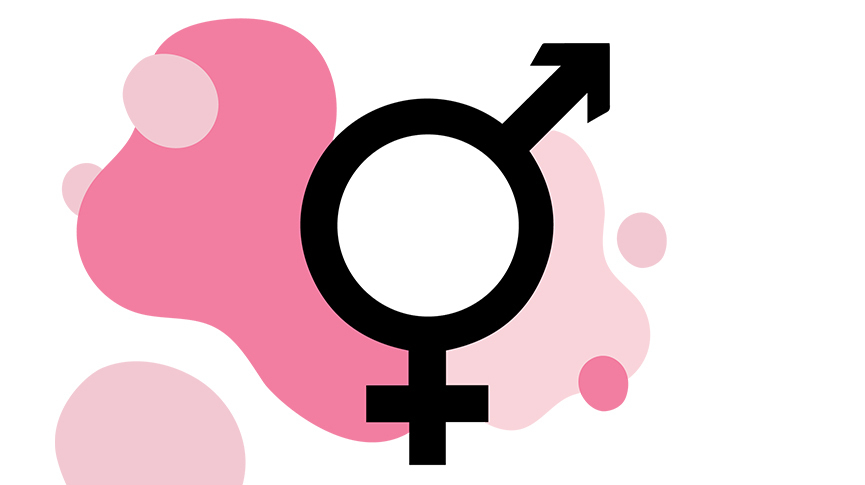What Does it Mean to Be Intersex?

Someone who is intersex has sex characteristics that don’t fit the societal notions of male and female bodies. Instead, it’s an umbrella term that makes room for all sorts of natural bodily variants. Let’s learn more about it!
We’ve written a lot about hormonal cycles and changes in your life. Yes, your monthly cycle of menstruation and fertility. But also the cycles of your life that take you from childhood through puberty, your reproductive years, and then menopause. While these cycles are on different schedules for every person, they all follow a more or less reliable path for most people.
But it doesn’t cover everyone. Some people might only find out when they’re not hitting the milestones that their peers are that they are intersex.
Biology Basics…and Beyond
If you took biology as a kid, you probably learned about cells. (The whole, ‘Mitochondria are the powerhouses of the cell’ thing.) And you learned about the sex cells, which have XX or XY chromosomes. According to our textbooks, if you have XY chromosomes you are a man and if you have XX you are a woman.
We now have a more nuanced idea of gender (reflected in such sources as the DSM-5). But many people don’t realize that biological sex isn’t quite that binary. This is for two reasons. One, a lot of the complex topics that we learn in elementary and high school are often simplified. That’s so we can get the basics down pat before we do a deeper dive into the concepts.
Secondly, our understanding can change. This is the cool part of not only science, but being a human – our views on the world can constantly evolve.
What does that have to do with sex?
Well, because despite what was probably explained in your ‘Intro to Human Biology’ textbooks, biological sex is a little more complicated. In terms of both genetic makeup and physical representation, biological sex is actually a range of expressions, with the ‘standard’ male and female sitting at either end of the continuum. If you want to see a diagram courtesy of Scientific American, it’s really complicated.
With chromosomes, genes, hormones, internal and external body parts and secondary sex characteristics (like breasts) all contributing to what makes up ‘biological’ sex, it’s no wonder things aren’t so clear cut.
Think less ‘flipping heads or tails’ and more giving 100 people different quantities of blue and yellow paint. Sure, there are going to be some definite blues and yellows at either end, but there’s going to be a lot of green in the middle.
Those various expressions of green were what was previously called ‘hermaphroditism,’ but we now use the term ‘intersex.’
What Does Being Intersex Look Like?
The tricky thing is, being ‘intersex’ might not look like anything at all! Intersex is an umbrella term used to describe a wide range of natural variations that affect a person’s genitals, hormones, chromosomes or reproductive organs. Some of these conditions can be observed at birth, some become apparent during puberty, and some you can’t see at all.
Sometimes, an XX intersex person will have female chromosomes and ovaries, but external genitalia that more closely resembles a penis and testes. Or the opposite might be true. Or, chromosomally, they may be XXY or XXX.
Essentially, an intersex person could have internal sex organs (ovaries and testes), that are different to their external ones (vagina and penis).
Some people might confuse the terms “intersex”, “hermaphrodite”, and “transgender”, but these are not interchangeable.
The term hermaphrodite is no longer politically correct or polite. Instead people say intersex, or someone with intersex characteristics or conditions. While intersex is biological, transgender on the other hand is someone whose gender differs from the sex they were assigned at birth.
People who are trans or non-binary may fall anywhere on the vast spectrum of gender. Someone who has intersex conditions, may be non-binary, or opt for trans-affirming surgeries or treatments to help them feel more comfortable about their gender.
Could I Be Intersex?
It’s possible! According to various estimates, including this conversation with an expert on the BBC, it is very hard to estimate numbers, for various reasons. And functionally, there is some debate as to what conditions are and are not examples of intersex. For example, late-onset congenital adrenal hyperplasia is a condition where an XX body creates too much testosterone. It can cause early puberty, facial hair and trouble conceiving, but is not considered to be an intersex condition by all clinicians.
If you wonder if you might be intersex, it’s important to realize a few things. One, because it refers to a range of conditions, it doesn’t look like just one thing. Secondly, you might need to search quite hard to find a specialist to speak with. Part of the reason why it is so hard to estimate how common intersex conditions actually are is that it can be shrouded in secrecy. Even today, many countries opt for surgery on infants to ‘correct’ perceived differences. But, activism in the intersex is growing, and the third thing you should realize is that you’re not alone!
Facts Checked By:

Dr. Shree Datta is a Consultant Obstetrician and Gynaecologist in London, specialising in women’s health including all menstrual problems such as fibroids and endometriosis. Dr. Shree is a keen advocate for patient choice, having written numerous articles and books to promote patient and clinician information. Her vision resonates with INTIMINA, with the common goals of demystifying periods and delivering the best possible care to her patients.
Article written by:

Natasha (she/her) is a full-spectrum doula and health+wellness copywriter. Her work focuses on deconstructing the shame, stigma, and barriers people carry around birth, sex, health, and beyond, to help people navigate through their lives with more education and empowerment. You can connect with Natasha on IG @natasha.s.weiss.


